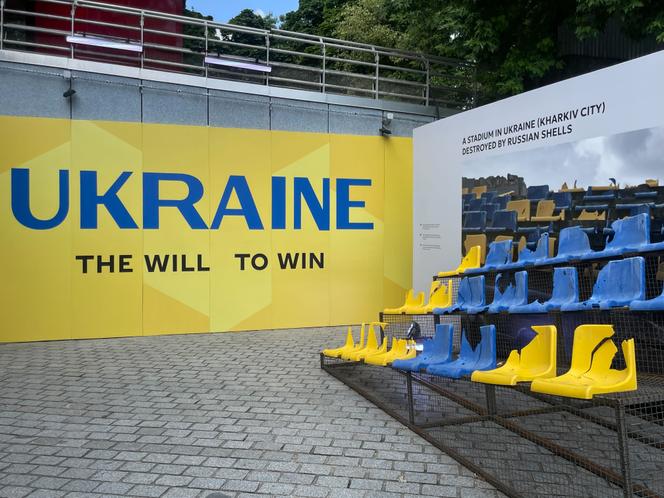


The Games are well underway, and so are multiple conflicts. When you walk into Ukraine's first-ever Olympic hospitality house in the La Villette neighborhood of Paris, it's clear the delegations' organizers don't want you to forget about it. Yellow-and-blue bleachers, the colors of the Ukrainian flag, dominate the space the minute you enter; most of the seats are broken, seemingly hit by shrapnel. The poster behind the scene confirms this: The seats are a replica of bleacher seats destroyed after Russia bombed a stadium in Kharkiv City.
When Paris Mayor Anne Hidalgo gave Ukrainian athletes the Grand Vermeil Medal on Thursday, July 31, as a move of solidarity during the 2024 Olympics, she told them she could "imagine today both your sadness and your pride." The feeling was evoked again when Ukraine's women's saber fencers Olga Kharlan, Alina Komaschuk, Olena Kravatska and Yulia Bakastova won the country their first gold medal in Paris on Saturday. On Sunday, Yaroslava Mahuchikh won Ukraine its second, in high jump.
Ukraine.
If you find yourself needing to ask a local where to find one of the hospitality houses, it's useful to know that the country you might be looking for is likely to have a different name to its English one. Ukraine, the house which I visited, is one of the easy ones, becoming l'Ukraine. Likewise, other countries, like Argentina (l'Argentine) or Ireland (l'Irlande), are simple. But others are a little less intuitive for an anglophone. The United Kingdom in French is le Royaume-Uni; Germany is l'Allemagne.
The Ukraine hospitality house, Volia Space, is nestled away from the festivities that can be experienced at other houses at La Villette. Made with the support of France, you can go there to watch the Games on the giant screen in the center of the space. But its main purpose is to showcase the country's wartime reality and national identity. A photo of Ukrainian athlete Andriy Protsenko, who'll be aiming high on Wednesday in the men's high jump qualification, is an apt reminder of this. Next to the bombed-out bleachers is a picture of Protsenko training in Kherson, which was temporarily occupied by Russia in 2022. The high jumper is one of the "lucky ones": 487 Ukrainian athletes have been killed by Russia's war on Ukraine, according to the country's sports minister.

It's also a reminder Ukraine's national identity is still alive and thriving – among Ukrainians and other nationalities. When I visited one Friday afternoon, French spectators cheered on the rowing teams, Spanish fans ate some Ukrainian cuisine, and an Irish couple, Barry and Frankie from Dublin, came to show their support for the wartorn country, concerned the world was becoming distracted. Barry told me he had volunteered in Ukraine three times with the NGO Lviv Volunteer Kitchen and was likely going back in October.

So while eating some borsch or cabbage rolls, take a moment to read the messages left on the two doors that take you into the main exhibition room. Messages like "Ukraine je t'aime," "Peace and love," "Tomorrow will be better," and simply "Bravery" cover the door in languages including French, English, Ukrainian, German, Italian and Spanish, to name just a few. From photography exhibitions to interviews with Ukrainian athletes to documentary projections, Volia Space is a place to somberly reflect on the jarring juxtaposition of the positivity of the Games and the conflicts taking place outside of them. Click here for the program.
Also hidden away nearby is the beautiful Philharmonic complex of concert halls. The building itself is worth taking in for a few moments. Despite standing some 52 meters high, the building is neither imposing nor out of place in the leafy northeastern Paris neighborhood. That's because its architect Jean Nouvel worked with architects of sites close by, like the Cité de la Musique, to ensure coherence. Look closely, and you'll see that the aluminum that covers the building is actually cut-outs of birds – 340,000 of them.
The Philharmonic also offers plenty of events and space outside of concerts. If your introduction to the French band Gojira during the opening ceremony left you craving more heavy metal, buy some tickets to the Philharmonic's Metal exhibition, on until September 29. The exhibition looks back to heavy metal's genesis 50 years ago, offering, for the first time in France, a documented picture of the movement.
You'll have likely heard of the Buttes-Chaumont and the Buttes-Montmarte, but there's a third secret butte, or "hill," in Paris on top of the Philharmonic building. You can go up to its rooftop free of charge for an impressive view of northeast Paris, where you'll see iconic Paris landmarks like the Buttes-Chaumont, the Montparnasse tower and the Eiffel tower, as well as the suburbs of Aubervilliers, Pantin and Les Lilas.
The Ukraine hospitality house is also a nice place to cool down and watch the Games – thanks to its location under La Villette's trees, part of the space is in the shade.
But if you've been disappointed by the frenetic Paris summer weather and want some terrace time in the sun, the "Jveuxdusoleil" ("I want sun") app can help you. Little sun pinpoints are marked across a map of Paris showing where you can sit with an espresso, or a spritz, to soak in some rays, depending on the time of day. Just click on one of the markers and it'll take you to its location in Google Maps.
Need an ally to navigate the Olympics? Whether you're in the French capital for the sport, the culture or the food, Le Monde's English edition has got you covered with a handy guide full of practical information and secret tips.
